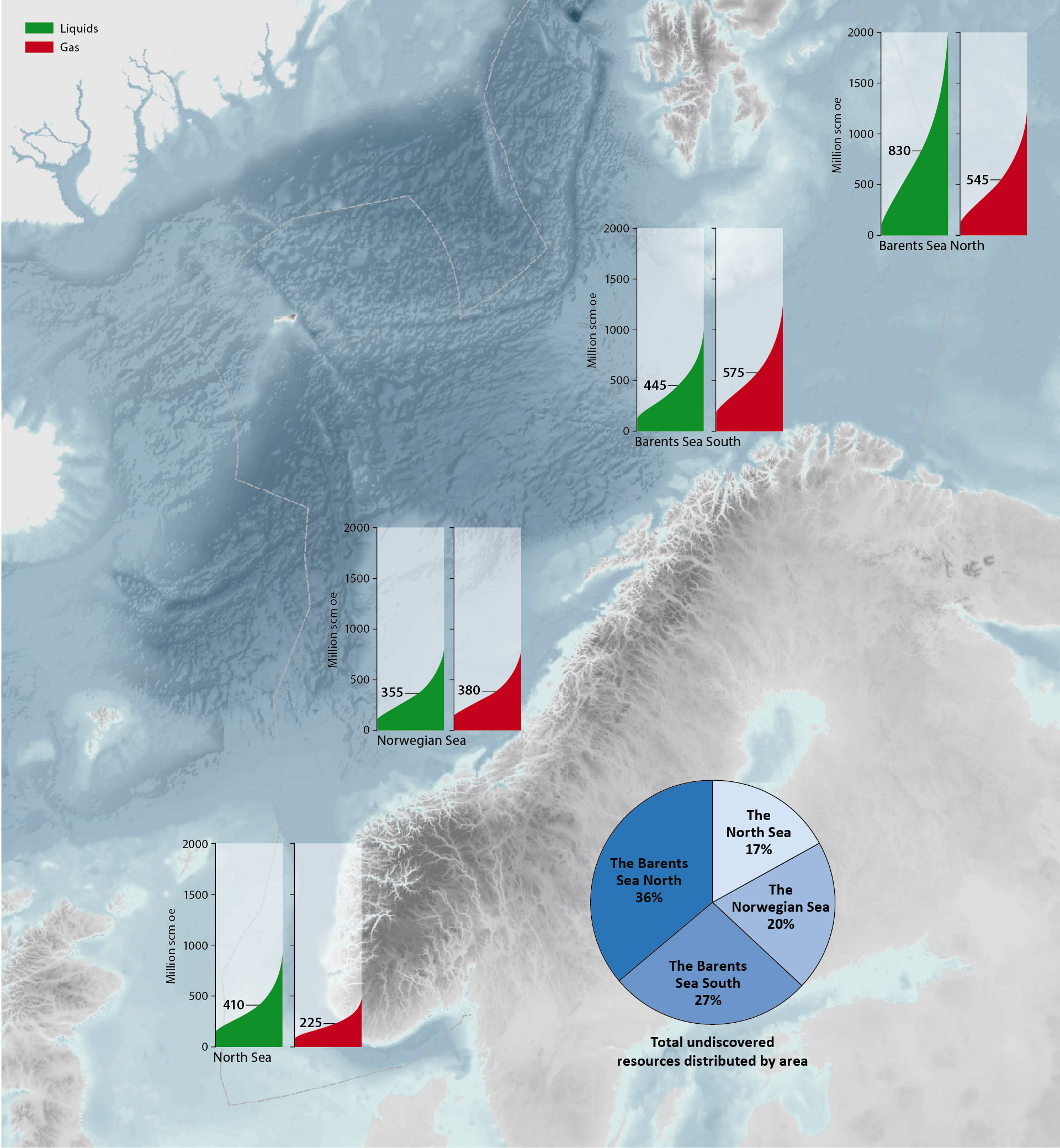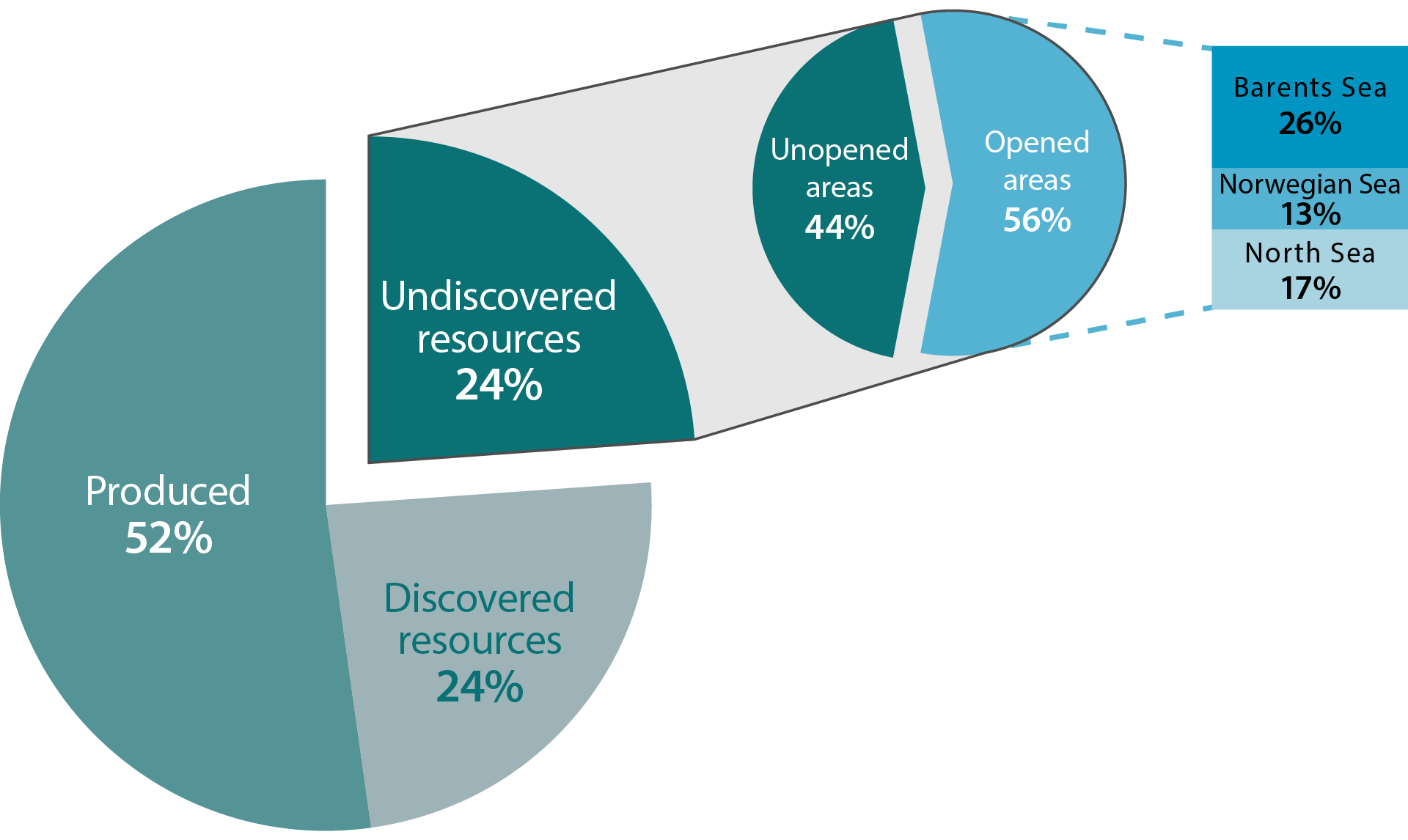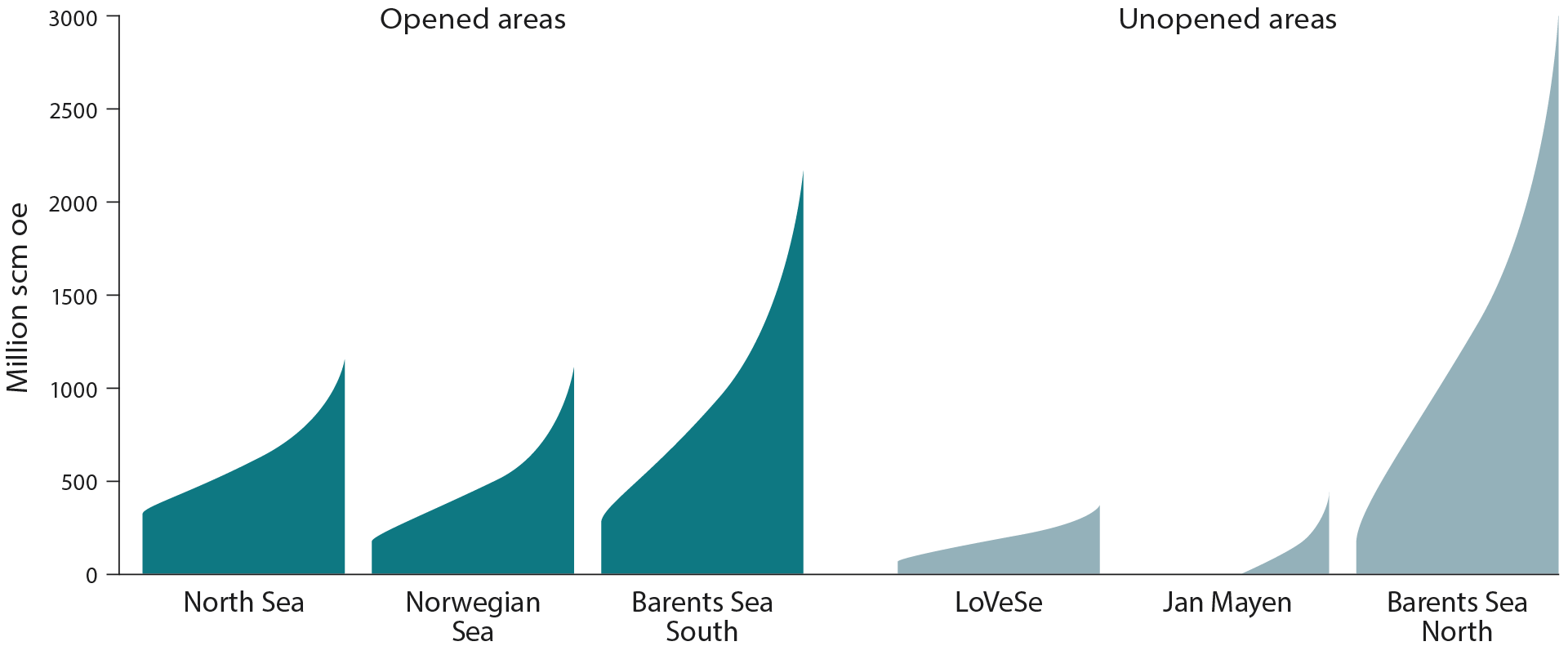3 – Undiscovered resources
Shortcut:
- 3.1 Undiscovered resources in opened and unopened areas
- 3.2 Undiscovered resources in Norwegian sea areas
Undiscovered resources are volumes of petroleum that we project could be recovered from deposits not yet proven through drilling.The estimates of undiscovered resources in areas opened for petroleum activities are updated every two years with an assessment of recent years' exploration results, new mapping and new documentation.
The projections were last updated in autumn 2021. The last year has only seen minor adjustments to the estimates, mainly as a result of exploration activity. Prospects that are drilled and do not become discoveries are removed, and prospects with discoveries are included in the discovered resources.

Figure 3-1 Distribution of undiscovered liquids and gas in the various sea areas with range of uncertainty
The pie chart in Figure 3-1 shows the percentage distribution between overall undiscovered resources in each sea area. More than 60 per cent of the undiscovered resources are located in the Barents Sea. In the Barents Sea North, we are expecting double the undiscovered liquids resources as in the other areas. This is where the uncertainty is greatest, which is reflected in the considerable range between the high and low estimates. The potential for gas on the Norwegian shelf is also greatest in the Barents Sea. It is distributed fairly equally between south and north.
Nevertheless, there are still considerable undiscovered resources in the North Sea and the Norwegian Sea, and with all existing infrastructure, there is a significant potential for value creation in these sea areas, even for discoveries of minor deposits. In the North Sea, we expect liquids to account for the largest share, while there is an equal distribution between undiscovered liquids and gas in the Norwegian Sea. The range of uncertainty shown in Figure 3 is from P95 to P05 in the estimated probability distribution for the resource outcome. The figures are listed in Table 3-1.
Table 3-1 Undiscovered resources by sea area with range of uncertainty.

3.1 Undiscovered resources in opened and unopened areas
The NPD expects undiscovered resources to make up 24 per cent of the overall resources on the Norwegian shelf. 56 per cent of this is in opened areas, 26 per cent of which is in the Barents Sea, 13 per cent in the Norwegian Sea and 17 per cent in the North Sea, as shown in Figure 3.

Figure 3-2 Distribution of undiscovered resources across opened and unopened areas.

Figure 3-3 Undiscovered resources in opened and unopened areas with range of uncertainty. LoVeSe is an abbreviation for the areas of Lofoten, Vesterålen and Senja.
Despite the somewhat greater resource potential in the Opened areas, the upside is greatest in the unopened part of the Barents Sea (Barents Sea North). This is also the area with the greatest uncertainty, as shown in Figure 3. The resources in LoVeSe are distributed between the Norwegian Sea and the Barents Sea South.
Table 3‑2 Undiscovered resources by sea area, in opened and unopened areas.

3.2 Undiscovered resources in Norwegian sea areas
North Sea
The estimate for undiscovered resources in the North Sea is 635 million Sm3 of recoverable oe. This is distributed between 410 million Sm3 oil and condensate (liquids) and 225 billion Sm3 gas.
Even in a mature area such as the North Sea, there is still significant uncertainty in the estimates for undiscovered resources, as illustrated in Figure 3.1. The figure shows a probability distribution where the low end is the P95 estimate (95 per cent likelihood that undiscovered resources exceed this value) and the high end is the P05 estimate (5 per cent likelihood that undiscovered resources exceed this value). These figures indicate the expected value in the distribution. This is normally somewhat higher than the P50 value.
Even if one cannot rule out that larger discoveries could be made in the North Sea, we expect that the majority of discoveries will be relatively small. The average discovery size in the North Sea over the last five years is 3.1 million Sm3 recoverable oe.
Norwegian Sea
The estimate for undiscovered resources in the Norwegian Sea is 735 million Sm3 recoverable oe. This is distributed between 355 million Sm3 oil and condensate and 380 billion Sm3 gas. The average discovery size in the Norwegian Sea has increased over the last five years and is now 5.5 million Sm3 recoverable oe.
The resource estimates for the Norwegian Sea also include the resource volumes in the unopened areas off Lofoten and Vesterålen, as well as in the sea area around Jan Mayen. These constitute about 33 per cent of the overall estimate.
Barents Sea
The estimate for undiscovered resources in the Barents Sea is 2,395 million Sm3 recoverable oe and is distributed between 1,275 million Sm3 oil and condensate and 1,120 billion Sm3 gas.
Exploration in the Barents Sea over the last five years has yielded mixed results. Exploration near infrastructure has been fruitful, while wells in new areas have been less successful. The average size of discoveries during this period has been 5.6 million Sm3 oe.
In the Barents Sea, 59 per cent of the resources are located in areas that have not been opened for petroleum activities, primarily in the Barents Sea North. This is the area with the greatest likelihood of making major new discoveries on the Norwegian shelf. There are considerable uncertainties associated with the projections in these areas. The NPD has been engaged in a geological mapping of the Barents Sea North based on new data collected since the previous mapping in 2016. Updated resource estimates for this area are not yet available and will be included in the Resource Accounts for 2023.